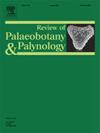Annotated catalog of the Egyptian macrofossil plants: An overview of over 200 years of research—Cryptogamae and Phanerogamae
IF 1.7
3区 地球科学
Q2 PALEONTOLOGY
引用次数: 0
Abstract
An annotated catalog of the Egyptian plant macrofossil remains is presented for the first time, based on a comprehensive assessment of the literature. Updated information on the plant macrofossils covering a period of over two centuries is incorporated. The catalog systematically comprises the records of all macrofossil taxa (including macroalgae) recovered from different Egyptian deposits. Taxa span from Devonian to Quaternary. A total of 643 taxa (130 calcareous algae, 172 pteridophytes, 97 gymnosperms, and 244 angiosperms), belonging to 317 genera and 130 families, are reported. The Cretaceous era represents the richest plant-bearing strata; over 100 taxa were recorded from these layers. The most represented angiosperm family was Arecaceae (39 species in 10 genera), followed by Fabaceae (30 species in 19 genera), then Moraceae (19 species in 4 genera). Leaves were the most diverse of all plant organs (108 taxa in 59 genera), followed by stems (87 taxa in 39 genera), then fruits and seeds (30 taxa in 21 genera). Other plant organs or parts of organs (rhizome, root, leaf petiole, and rachis) were rarely encountered as fossils. Flowers have never been reported. Families, genera, and specific epithets are arranged in alphabetical order, followed by synonyms. For each taxon, a brief annotation of the locality(ies), the geological age(s), and the literature citing the taxon from Egypt is also provided. A synopsis of orders, families, subfamilies, and genera is given. Descriptions and illustrations are planned for special subsequent publications.

埃及大型化石植物注释目录:200多年研究综述-隐gamae和显gamae
埃及植物大化石遗骸的注释目录首次提出,基于文献的综合评估。收录了两个多世纪以来植物宏观化石的最新信息。该目录系统地包括从不同的埃及沉积物中恢复的所有大型化石分类群(包括大型藻类)的记录。分类群跨度从泥盆纪到第四纪。报告了130科317属643个分类群,其中钙质藻类130个,蕨类172个,裸子植物97个,被子植物244个。白垩纪是植物生长最丰富的地层;在这些地层中记录了100多个分类群。被子植物科中最具代表性的是槟榔科(10属39种),其次是豆科(19属30种),其次是桑科(4属19种)。在所有植物器官中,叶片的多样性最高(59属108个分类群),其次是茎(39属87个分类群),其次是果实和种子(21属30个分类群)。其他植物器官或器官的部分(根茎、根、叶柄和轴)很少作为化石被发现。花儿从未被报道过。科、属和特定的绰号按字母顺序排列,然后是同义词。对于每个分类单元,还提供了地点(ies),地质时代(s)和引用埃及分类单元的文献的简要注释。给出了目、科、亚科和属的概要。计划在以后的特别出版物中作说明和插图。
本文章由计算机程序翻译,如有差异,请以英文原文为准。
求助全文
约1分钟内获得全文
求助全文
来源期刊
CiteScore
3.50
自引率
21.10%
发文量
149
审稿时长
6 months
期刊介绍:
The Review of Palaeobotany and Palynology is an international journal for articles in all fields of palaeobotany and palynology dealing with all groups, ranging from marine palynomorphs to higher land plants. Original contributions and comprehensive review papers should appeal to an international audience. Typical topics include but are not restricted to systematics, evolution, palaeobiology, palaeoecology, biostratigraphy, biochronology, palaeoclimatology, paleogeography, taphonomy, palaeoenvironmental reconstructions, vegetation history, and practical applications of palaeobotany and palynology, e.g. in coal and petroleum geology and archaeology. The journal especially encourages the publication of articles in which palaeobotany and palynology are applied for solving fundamental geological and biological problems as well as innovative and interdisciplinary approaches.

 求助内容:
求助内容: 应助结果提醒方式:
应助结果提醒方式:


